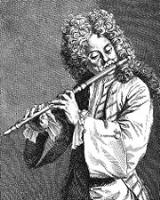
Jacques-Martin Hotteterre
Encyclopedia

French people
The French are a nation that share a common French culture and speak the French language as a mother tongue. Historically, the French population are descended from peoples of Celtic, Latin and Germanic origin, and are today a mixture of several ethnic groups...
composer
Composer
A composer is a person who creates music, either by musical notation or oral tradition, for interpretation and performance, or through direct manipulation of sonic material through electronic media...
and flautist
Flautist
A flautist or flutist is a musician who plays an instrument in the flute family. See List of flautists.The choice of "flautist" versus "flutist" is the source of dispute among players of the instrument...
. Jacques-Martin Hotteterre was the most celebrated of a family of wind instrument makers and wind performers.
Biography
Jacques-Martin Hotteterre was born in Paris, the son of Martin Hotteterre (d. 1712) and Marie Crespy. In about 1704, Jacques-Martin Hotteterre succeeded his cousin Jacques in the post of basse de hautbois et taille de violon at the royal court.Hotteterre lived and studied in Rome early in his career, and his nickname le Romain (the Roman) came from this period. He spent two years (1698–1700) employed by Prince Francesco Ruspoli in Rome, before adopting the nickname of "Le Romain" at some point between 1705 and 1707. By 1708, he became a musician to the king of France, in the king's Grande Écurie, and in 1717, he inherited René Pignon Descoteaux's post as Jouëur de Fluste de la musique de chambre.
Hotteterre owed his fame largely to his talent playing the flute
Flute
The flute is a musical instrument of the woodwind family. Unlike woodwind instruments with reeds, a flute is an aerophone or reedless wind instrument that produces its sound from the flow of air across an opening...
, an instrument for which he wrote a number of pieces, significantly extending the repertory for the instrument. In addition, he played the bassoon
Bassoon
The bassoon is a woodwind instrument in the double reed family that typically plays music written in the bass and tenor registers, and occasionally higher. Appearing in its modern form in the 19th century, the bassoon figures prominently in orchestral, concert band and chamber music literature...
, oboe
Oboe
The oboe is a double reed musical instrument of the woodwind family. In English, prior to 1770, the instrument was called "hautbois" , "hoboy", or "French hoboy". The spelling "oboe" was adopted into English ca...
, and musette
Musette de cour
The musette de cour or baroque musette is a musical instrument of the bagpipe family. Visually, the musette is characterised by the short, cylindrical shuttle-drone and the two chalumeaux. Both the chanters and the drones have a cylindrical bore and use a double reed, giving a quiet tone similar to...
. Jacques-Martin Hotteterre was also an internationally celebrated teacher to aristocratic patrons. He wrote one method for the transverse flute, recorder, and oboe, published in 1707, as well as a method for the musette, published in 1737. His L'Art de préluder sur la flûte traversière was published in 1719. It underscores his highly developed technique and includes pieces in nineteen keys.
In addition to performance and teaching, Hotteterre continued his family's tradition of wind instrument making. It may have been Hotteterre who made a number of changes in the design of the transverse flute, though there is little concrete evidence for this. Most notably, the flute, which had previously been made in one cylindrical piece, was cut in three pieces: the head (with the mouthpiece), the body (with most of the holes), and the foot (with one, keyed hole for the low E).
He died in Paris in 1763.
Compositions
- Op. 1 Principes de la flûte traversière, ou flûte d'Allemangne, de la flûte à bec ou flûte douce et du hautbois, divisez par traictez (1701)
- Op. 2 Premier livre de pièces pour la flûte traversière et autres instruments avec la basse (1708)
- Op. 3 Sonates en trio pour les flûtes traversières et a bec, violon, hautbois (1712)
- Op. 4 Première suitte de pièces suite de pièces à deux dessus, sans basse continue. Pour les flûtes-traversières, flûtes à bec, violes, " (1712)
- Op. 5 Deuxième livre de pièces pour la flûte traversière et autres instruments avec la basse (1715)
- Op. 6 Deuxième suite de pièces à deux dessus pour les flûtes-traversières, flûtes à bec, violes, etc... avec une basse adjoutée et sans altération des dessus, laquelle on y pourra joindre pour le concert" (1717)
- Op. 7 L'art de Préluder (1719)
- Op. 8 Troisième suite de pièces à deux dessus (1722)
- Op. 9 Concert de Rossignol (lost)
- Op. 10 Méthode pour la MusetteMusette de courThe musette de cour or baroque musette is a musical instrument of the bagpipe family. Visually, the musette is characterised by the short, cylindrical shuttle-drone and the two chalumeaux. Both the chanters and the drones have a cylindrical bore and use a double reed, giving a quiet tone similar to...
contenant des principes, par un recueil d'airs et quelques préludes (1738)
- Airs et brunettes à deux et trois dessus avec la basse - Tirez des meilleurs autheurs (1721)
- Arrangements of pieces by Valentine and Torelli for two flutes
- Arrangement of trios by Albinoni (lost)

